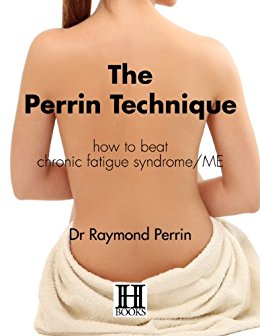The Perrin Technique
The Perrin technique is a bio-mechanical treatment consisting of lymphatic drainage, spinal and cranial osteopathy developed by UK-based osteopath Raymond Perrin for patients suffering from myalgic encephalomyelitis/chronic fatigue syndrome (ME/CFS).[1]
The Perrin technique is based on the hypothesis that the underlying cause of ME/CFS is impaired function of the lymphatic[2] and "glymphatic"[3] systems.
Diagnostic signs[edit | edit source]
Perrin argues that there are five physical signs are almost always present in those who suffer from ME/CFS:
- mechanical disturbances of the thoracic spine
- breast varicosities
- tender Perrin’s point (third left intercostal space)[4]
- tender coeliac plexus, and
- dampened cranial flow[5]
Perrin proposes that examination for these five signs is a more accurate means of definitively diagnosing ME/CFS than the commonly used Canadian Consensus Criteria[6] or a diagnosis of exclusion.
The Perrin technique's diagnostic clinical assessment involves assessing patient symptoms and detailed history and uses these signs as a positive aid to diagnosis rather than the commonly used diagnosis by exclusion. Using the full clinical protocol licensed practitioners should be able to score the severity giving an idea of the prognosis and how long it will take for the treatment to be beneficial.
Theory[edit | edit source]
The Perrin technique is a bio-mechanical form of therapy for ME/CFS based on the hypothesis that problems with the lymphatic drainage of toxins from the central nervous system are common in patients, with the toxins having resulted from infection, pollution and emotional or physical trauma.[1] The Perrin technique hypothesis is that autonomic system dysfunction causes a disturbance of neurotransmitters such as acetylcholine", often resulting in a build-up of choline levels in the brain. The supplement EPA is added to help repair damage caused by the neurotoxins. A part of the brain known as the hypothalamus is also involved.
The Perrin technique is claimed to produce a lasting improvement in symptoms of ME/CFS.[1]
Evidence[edit | edit source]
A Blinded control clinical trial has been carried out showing that the physical signs mentioned above are useful as an aid to diagnosis [5] .The ME association (UK) survey in 2010 listed The Perrin Technique 3rd highest in their list of 25 treatments as recommended by patient preference. Individual case reports provide some limited evidence of improvement.
Notable studies[edit | edit source]
- 2010, Perrin: EPA and the Perrin Technique: a combined approach to treating myalgic encephalomyelitis[1] - (Abstract)
- 2017, Can physical assessment techniques aid diagnosis in people with chronic fatigue syndrome/myalgic encephalomyelitis? A diagnostic accuracy study[5] (Full text)
Clinicians[edit | edit source]
- Raymond Perrin
- List of licensed Perrin Technique practitioners available on www.the perrintechnique.com
Risks and safety[edit | edit source]
Costs and availability[edit | edit source]
Book[edit | edit source]
The Perrin Technique: How to Beat Chronic Fatigue Syndrome/ME is a self-help book by Raymond Perrin.
The Perrin Technique 2nd edition. The diagnosis and treatment of chronic fatigue syndrome /ME and Fibromalgia via the lymphatic drainage of the brain. Published by Hammersmith Press: March 2021 (Available in print and kindle version)
Out August 2021: The Concise Perrin Technique : A Handbook for patients
See also[edit | edit source]
Learn more[edit | edit source]
References[edit | edit source]
- ↑ 1.0 1.1 1.2 1.3 https://doi.org/10.1186/1744-859X-9-S1-S25
- ↑ Perrin, Raymond N. (2007). The Perrin technique : how to beat chronic fatigue syndrome/ME. London: Hammersmith. ISBN 978-1-905140-12-1. OCLC 244652322.
- ↑ Iliff, J.J.; Wang, M.; Liao, Y.; Plogg, B.A.; Peng, W.; Gundersen, G.A.; Benveniste, H.; Vates, G.E.; Deane, R. (August 15, 2012). "A Paravascular Pathway Facilitates CSF Flow Through the Brain Parenchyma and the Clearance of Interstitial Solutes, Including Amyloid". Science Translational Medicine. 4 (147): 147ra111–147ra111. doi:10.1126/scitranslmed.3003748. ISSN 1946-6234. PMC 3551275. PMID 22896675.
- ↑ Puri, BK; Gunatilake, KDR; Fernando, KAC; Gurusinghe, AI; Agour, M; Treasaden, IH (February 2011). "Increased Tenderness in the Left Third Intercostal Space in Adult Patients with Myalgic Encephalomyelitis: A Controlled Study". Journal of International Medical Research. 39 (1): 212–214. doi:10.1177/147323001103900122. ISSN 0300-0605.
- ↑ 5.0 5.1 Hives, Lucy; Bradley, Alice; Richards, Jim; Sutton, Chris; Selfe, James; Basu, Bhaskar; Maguire, Kerry; Sumner, Gail; Gaber, Tarek (November 2017). "Can physical assessment techniques aid diagnosis in people with chronic fatigue syndrome/myalgic encephalomyelitis? A diagnostic accuracy study". BMJ Open. 7 (11): e017521. doi:10.1136/bmjopen-2017-017521. ISSN 2044-6055. PMC 5695376. PMID 29133321.
- ↑ Carruthers, Bruce M.; Jain, Anil Kumar; De Meirleir, Kenny L.; Peterson, Daniel L.; Klimas, Nancy G.; Lerner, A. Martin; Bested, Alison C.; Flor-Henry, Pierre; Joshi, Pradip (January 2003). "Myalgic Encephalomyelitis/Chronic Fatigue Syndrome: Clinical Working Case Definition, Diagnostic and Treatment Protocols". Journal of Chronic Fatigue Syndrome. 11 (1): 7–115. doi:10.1300/J092v11n01_02. ISSN 1057-3321.


